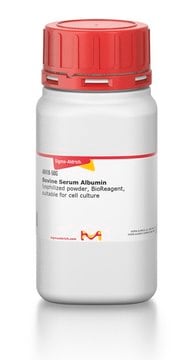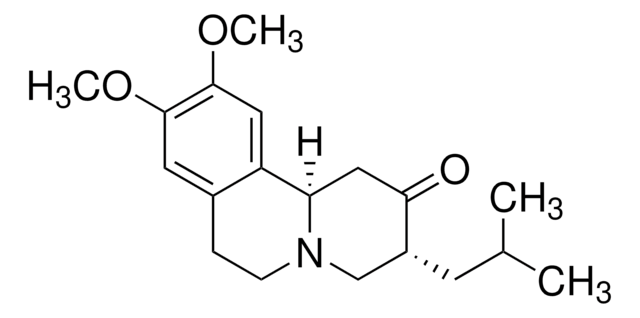T8694
TrkB/Fc Chimera human
>90% (SDS-PAGE), recombinant, expressed in NSO cells, lyophilized powder
Autenticatiper visualizzare i prezzi riservati alla tua organizzazione & contrattuali
About This Item
Prodotti consigliati
Origine biologica
human
Livello qualitativo
Ricombinante
expressed in NSO cells
Saggio
>90% (SDS-PAGE)
Stato
lyophilized powder
Potenza
0.1-0.4 μg/mL ED50
PM
120-130 kDa by SDS-PAGE (reducing)
calculated mol wt 71 kDa
Confezionamento
pkg of 100 μg
Condizioni di stoccaggio
avoid repeated freeze/thaw cycles
tecniche
western blot: suitable
Impurezze
endotoxin, tested
N° accesso UniProt
Temperatura di conservazione
−20°C
Informazioni sul gene
human ... NTRK2(4915)
Applicazioni
TrkB/Fc Chimera human can be used in synaptoneurosome preparation and western blot analysis. Intracerebroventricular administeration of TrkB/Fc chimera human blocks TrkB ligand signaling and was used to study the role of BDNF in ATN response augmentation.
Azioni biochim/fisiol
Binds specifically to mediate neurotrophins BDNF and NT-4/5.
Member of the Trk family tyrosine kinase receptors. Binds specifically to mediate neurotrophins BDNF and NT-4/5.
TrkB/Fc Chimera human consist of extracellular domain of human TrkB1 fused to histidine-tagged Fc region of human IgG1 by using a polypeptide linker. TrkB belongs to tyrosine kinase receptors family and facilitates the hippocampal development as well as regulating the synaptic plasticity that underlies long-term potentiation and learning. Brain derived neurotrophic factor (BDNF) and Neurotrophin 4 or 5 are preferred ligands for TrkB. Nevertheless it can also bind to NTF3/neurotrophin-3 that is less efficient in activating the receptor but regulates neuron survival through NTRK2.
Altre note
Extracellular domain of human TrkB fused to the C-terminal histidine-tagged Fc region of human IgG1.
Stato fisico
Lyophilized from 0.2 μm filtered solution in phosphate buffered saline.
Ricostituzione
Reconstitute to 100 μg/mL in phosphate buffered saline.
Risultati analitici
Inhibits BDNF-induced proliferation of TrkB transfected cells, BaF-TrkB-BD.
Codice della classe di stoccaggio
11 - Combustible Solids
Classe di pericolosità dell'acqua (WGK)
WGK 3
Punto d’infiammabilità (°F)
Not applicable
Punto d’infiammabilità (°C)
Not applicable
Scegli una delle versioni più recenti:
Possiedi già questo prodotto?
I documenti relativi ai prodotti acquistati recentemente sono disponibili nell’Archivio dei documenti.
Yun-yue Ju et al.
Acta pharmacologica Sinica, 36(12), 1437-1443 (2015-11-17)
Brain-derived neurotrophic factor (BDNF) plays an important role in learning and memory in multiple brain areas. In the present study, we investigated the roles of BDNF in aversive memories associated with conditioned drug withdrawal in acute morphine-dependent rats. Conditioned place
Marian Tsanov et al.
Hippocampus, 21(1), 1-8 (2010-01-01)
The hippocampus projects to the anterior thalamic nuclei both directly and indirectly via the mammillary bodies, but little is known about the electrophysiological properties of these convergent pathways. Here we demonstrate, for the first time, the presence of long-term plasticity
Di Liu et al.
Neuropsychopharmacology : official publication of the American College of Neuropsychopharmacology, 45(9), 1557-1566 (2020-05-20)
Lithium has been used to treat major depressive disorder, yet the neural circuit mechanisms underlying this therapeutic effect remain unknown. Here, we demonstrated that the ventral tegmental area (VTA) dopamine (DA) neurons that project to the medial prefrontal cortex (mPFC)
Lulu Y Chen et al.
Proceedings of the National Academy of Sciences of the United States of America, 107(15), 7030-7035 (2010-04-02)
Learning-induced trophic activity is thought to be critical for maintaining health of the aging brain. We report here that learning, acting through an unexpected pathway, activates synaptic receptors for one of the brain's primary trophic factors. Unsupervised learning, but not
N Ninkina et al.
The Journal of biological chemistry, 272(20), 13019-13025 (1997-05-16)
We have isolated two novel variants involving the extracellular domain of TrkB from developing sensory neurons. These variants are generated by alternative splicing and lack two or all three of the leucine-rich motifs. Each of these variants is expressed as
Il team dei nostri ricercatori vanta grande esperienza in tutte le aree della ricerca quali Life Science, scienza dei materiali, sintesi chimica, cromatografia, discipline analitiche, ecc..
Contatta l'Assistenza Tecnica.





